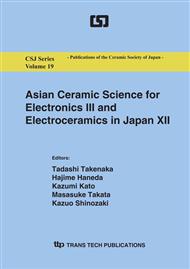p.239
p.243
p.247
p.251
p.255
p.259
p.263
p.269
p.273
Dielectric Properties of Bi0.2K0.8(Zn0.1Ti0.1)Ta0.8O3 Ceramics
Abstract:
The Bi0.2K0.8(Zn0.1Ti0.1)Ta0.8O3 and Li doped ceramics prepared via the solid-state reaction technique were investigated. The XRD patterns show the single phase cubic perovskite structure without any evidence of secondary phases when sintered at 1250 oC for undoped Bi0.2K0.8(Zn0.1Ti0.1)Ta0.8O3 and sintered at 1100 oC for Li doped one. The dielectric properties indicate the diffused phase transition (DPT). The dielectric loss of undoped ceramic increases with increasing frequency in temperature range 270 oC down to -150 oC, which suggests low temperature relaxation, while the dielectric loss of Li doped ceramic reveals the interesting lower value over a wide temperature range of about 0 - 300 oC.
Info:
Periodical:
Pages:
255-258
Citation:
Online since:
December 2009
Keywords:
Price:
Сopyright:
© 2010 Trans Tech Publications Ltd. All Rights Reserved
Share:
Citation:


